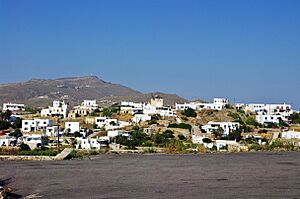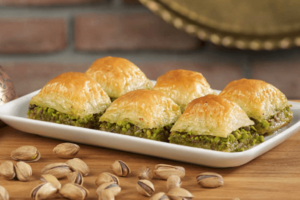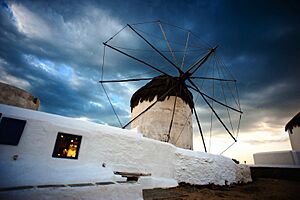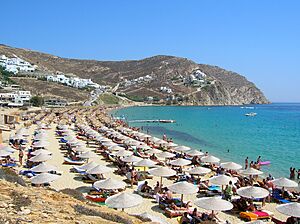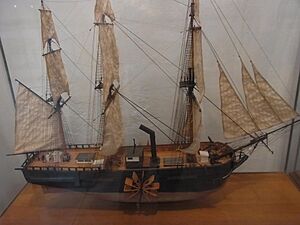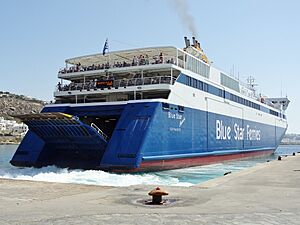Mykonos facts for kids
Quick facts for kids
Mykonos
Μύκονος
Nickname: Νησί των ανέμων (Nisí ton anémon, 'Island of the winds') |
|
|---|---|
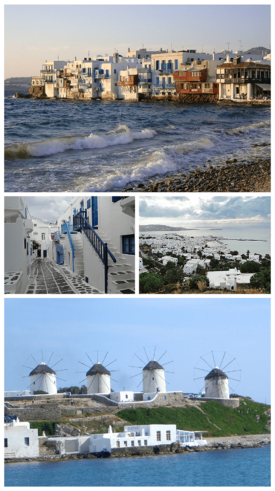 Clockwise from top: View of Little Venice in Mykonos, panoramic view of Chora (Mykonos City), the four windmills of Mykonos and the streets of Chora
|
|
| Country | Greece |
| Administrative region | South Aegean |
| Area | |
| • Municipality | 85.5 km2 (33.0 sq mi) |
| Population
(2021)
|
|
| • Municipality | 10,704 |
| • Municipality density | 125.19/km2 (324.25/sq mi) |
| Demonym(s) | Mykonians |
| Community | |
| • Population | 8,609 (2021) |
| Time zone | UTC+2 (EET) |
| • Summer (DST) | UTC+3 (EEST) |
| Postal code |
846 00
|
| Area code(s) | 22890 |
Mykonos is a beautiful Greek island. It is part of a group of islands called the Cyclades. Mykonos is located between the islands of Tinos, Syros, Paros, and Naxos.
The island is about 85.5 square kilometres (33.0 sq mi) in size. Its highest point is 341 metres (1,119 feet) tall. In 2021, about 10,704 people lived there. Most of them live in the main town, also called Mykonos. This town is on the west coast and is also known as Chora. This is a common Greek name for the main town on an island.
Mykonos is often called "The Island of the Winds." This is because strong winds blow there very often. The island is famous for its fun nightlife and is a very popular place for tourists to visit.
Contents
History of Mykonos
Long ago, a writer named Herodotus said that the first people on Mykonos were the Carians. Later, in the early 11th century BC, people called Ionians from Athens came to live there.
Mykonos was close to the important island of Delos, only 2 km (1.2 miles) away. This made Mykonos a key spot for getting supplies and for travelers to pass through. In ancient times, Mykonos was not a rich island. It had limited farms. The people living there believed in many gods, which is called polytheism.
Mykonos became part of the Roman Empire and then the Byzantine Empire until the 12th century. In 1204, after Constantinople fell during the Fourth Crusade, Mykonos was taken over by Andrea Ghisi. Later, in the late 13th century, the island was attacked by the Catalan Company. Finally, in 1390, it came under the direct rule of Venice.
In 1537, while the Venetians were still in charge, the island was attacked by Hayreddin Barbarossa. He was an admiral for the Ottoman Empire. The Ottomans then set up their own government on the island. This government had a leader and a group of advisors. When the Ottomans took the castle of Tinos in 1718, the last Venetians left the area.
Until the late 1700s, Mykonos was a busy trading center. Many people from nearby islands moved there. However, pirates also raided the island often. In June 1794, a sea battle between British and French ships happened in Mykonos' main harbor.
The Greek Revolution against the Ottoman Empire started in 1821. Mykonos played a big part in this fight. A national hero named Manto Mavrogenous led the way. She was a smart and well-educated woman who believed in new ideas. She used her family's money to help Greece become free. Greece finally became an independent country in 1830. Today, there is a statue of her in the main town's Manto Mavrogenous square.
After the revolution, Mykonos' economy grew quickly because of sailing and trade. But it slowed down again in the late 1800s. This happened especially after the Corinth Canal opened in 1904 and after First World War began. Many people from Mykonos left the island to find work in mainland Greece or other countries, like the United States.
Tourism soon became the most important part of the island's economy. This was helped by important discoveries made by French archaeologists on Delos starting in 1873. Mykonos became very popular with international travelers in the 1960s. By the 2000s, Mykonos was known as one of Greece's most expensive islands.
Mythology of Mykonos
In Greek mythology, Mykonos got its name from its first ruler, Mykonos. He was said to be the son or grandson of the god Apollo.
People also say that Mykonos was the place of the Gigantomachy. This was a huge battle between the god Zeus and the powerful Giants. It is believed that Heracles killed the giants here. He tricked them away from the safety of Mount Olympus. According to the myth, the many large rocks all over the island are the bodies of these giants turned into stone.
Geography of Mykonos
Mykonos is about 85.5 square kilometres (33.0 sq mi) in area. Its highest point is 341 metres (1,119 feet) high. The island is located 150 kilometres (93 miles) east of Athens in the Aegean Sea. Mykonos does not have any rivers. However, it has many streams that flow only during certain seasons. Two of these streams have been turned into places to store water.
The island is mostly made of granite rock. The land is very rocky, and strong winds have worn away many areas. High-quality clay and a mineral called baryte were mined on the eastern side of Mykonos until the late 1900s. Baryte is used as a lubricant when drilling for oil.
Mykonos produces 4,500 cubic metres (160,000 cu ft) of water every day. It does this by using a process called reverse osmosis on sea water. This helps to provide enough water for the people who live there and for all the visitors.
The island has almost 12,500 people living on it. Most of them live in the main town of Chora.
Climate of Mykonos
Mykonos has a hot semi-arid climate. This means it does not get much rain overall. However, it also has many features of a Mediterranean climate. The Aegean Sea greatly affects its weather.
The rainy season on Mykonos lasts from October to March. Plants typically grow from mid-autumn until the beginning of summer. The average temperature during the day in winter is around 15 °C (59 °F). In summer, it is around 27.0 °C (80.6 °F). At night, the average temperature is 11 °C (52 °F) in winter and 24 °C (75 °F) in summer.
Summers are usually cool, dry, sunny, and pleasant. This is because of the seasonal cool "meltemi" wind and the sea, which keeps temperatures mild. The low rainfall is due to the rain shadow effect from the Pindus mountain range. This mountain range blocks and dries out winds coming from the west. Winters are generally mild and wet, with many sunny days even in the middle of winter. Snow does not fall often and does not stay on the ground for long when it does.
| Climate data for Mykonos | |||||||||||||
|---|---|---|---|---|---|---|---|---|---|---|---|---|---|
| Month | Jan | Feb | Mar | Apr | May | Jun | Jul | Aug | Sep | Oct | Nov | Dec | Year |
| Mean daily maximum °C (°F) | 14.3 (57.7) |
14.9 (58.8) |
16.0 (60.8) |
18.8 (65.8) |
22.9 (73.2) |
26.3 (79.3) |
27.5 (81.5) |
27.5 (81.5) |
25.6 (78.1) |
21.9 (71.4) |
19.0 (66.2) |
16.0 (60.8) |
20.9 (69.6) |
| Daily mean °C (°F) | 12.5 (54.5) |
13.1 (55.6) |
14.1 (57.4) |
16.7 (62.1) |
20.5 (68.9) |
24.0 (75.2) |
25.8 (78.4) |
25.9 (78.6) |
23.9 (75.0) |
20.3 (68.5) |
17.4 (63.3) |
14.2 (57.6) |
19.0 (66.3) |
| Mean daily minimum °C (°F) | 10.7 (51.3) |
11.3 (52.3) |
12.1 (53.8) |
14.5 (58.1) |
18.1 (64.6) |
21.7 (71.1) |
24.1 (75.4) |
24.4 (75.9) |
22.2 (72.0) |
18.7 (65.7) |
15.7 (60.3) |
12.4 (54.3) |
17.2 (62.9) |
| Average rainfall mm (inches) | 73.1 (2.88) |
60.6 (2.39) |
32.7 (1.29) |
16.5 (0.65) |
6.4 (0.25) |
4.2 (0.17) |
0.1 (0.00) |
1.6 (0.06) |
12.1 (0.48) |
26.2 (1.03) |
36.2 (1.43) |
57.2 (2.25) |
326.9 (12.88) |
| Source: National Observatory of Athens Monthly Bulletins (Jul 2008-Mar 2023) | |||||||||||||
Villages of Mykonos
Mykonos has ten villages:
- Agios Ioannis
- Agios Stefanos
- Ano Mera
- Ftelia
- Kalafati
- Mykonos or Chora
- Ornos
- Platys Gialos
- Psarrou
- Tourlos
Cuisine of Mykonos
When you visit Mykonos, you can try these local foods:
- Kopanisti Mykonou (a type of cheese)
- Kremmydopita (onion pie)
- Louza (a type of cured meat)
- Omeletta (omelette)
- Amygdalota (a sweet almond dessert)
- Lazarakia (a sweet bread often made for Easter)
- Melopita (a honey pie dessert)
- Ksinotira (a sour cheese appetizer)
- Baklava (a sweet pastry dessert)
Population of Mykonos
Here's how the population of Mykonos has changed over the years:
| Year | Municipality population |
|---|---|
| 1971 | 3,863 |
| 1981 | 5,530 |
| 1991 | 6,179 |
| 2001 | 9,320 |
| 2011 | 10,134 |
| 2021 | 10,704 |
Economy of Mykonos
Like many Greek islands, Mykonos' economy has always been connected to the sea. However, with the growth of tourism, fishing and shipping play a smaller role during the summer months. Tourism is now the main industry.
Landmarks of Mykonos
- Municipal Library – This is an old mansion from the 1700s. It holds over 8,000 books. It also has a huge collection of old photos, documents, and coins from the 1700s and 1800s. You can find it in Ayia Kyriaki Square in the main town of Chora.
- Petros the Pelican – Petros is a famous pelican who has been the official mascot of Mykonos for more than 60 years! The first Petros came to the island after a storm in 1954. After he passed away, the islanders chose a new pelican to continue his legacy.
- Mykonos windmills – These windmills are a very important part of the Mykonos landscape. Many are scattered around the island, but most are in the main town of Chora. The famous "Kato Mili" (meaning lower mills) in Chora stand in a line on a hill. They face the sea to catch the strong northern winds. These windmills were built by the Venetians in the 1500s to grind flour. They were used until the early 1900s. Many have been fixed up and now serve as homes or places to keep old Mykonian documents.
- Camel Rock – This is a rock formation in the sea near the windmills at "Kato Mili." It looks like a camel sitting in the shallow blue-green water, which is how it got its name.
- Little Venice – This area has rows of old fishing houses right on the waterfront. Their balconies hang over the sea! The first of these houses were built in the mid-1700s. They used to belong to rich traders or ship captains. The small doors in their basements led directly to the sea. People used to think the owners might have been secret pirates because of these hidden entrances. Today, some of these houses are bars, cafes, shops, and art galleries. Little Venice is known as one of the most romantic places on the island. Many people go there to watch the sunset. Artists also love to visit and paint the beautiful coastline.
- Armenistis Lighthouse – This lighthouse shows Mykonos' long history with the sea. It is still working today! It is located in a place called Fanari, which means "lantern" in Greek. It is about 6.5 km (4.0 mi) from Chora.
- Tria Pigadia – These are three identical wells that stand in a row in the middle of Chora, the main town. They were built in 1722 to give the town water. Unlike most modern wells that are very deep, these wells are only 5–6 metres (16–20 ft) deep. This is because they were dug into sand where water was easier to find.
- Archaeological Museum of Mykonos – This museum was built in 1905. It was made to hold things found in a special pit on the nearby islet of Rheneia. These items were discovered in 1898. It is one of the oldest museums in Greece. The museum has items from Rhenia, including pottery from the 800s and 700s BC. It also has works from other parts of the Aegean Sea from the 600s and 700s BC. Its most famous item is a large vase from Tinos, which shows scenes from the fall of Troy.
- Aegean Maritime Museum – This museum was started in 1983 by George M. Drakopoulos from Mykonos. It opened in 1985. Its goal is to save and share the history of Greek ships and sea traditions. It focuses on how merchant ships changed and were used in the Aegean Sea. This museum was the first in Greece to save and fix up old ships so they could work again as they were first designed. Besides real old items, the museum also has copies of historical ships. It has collections of old coins with sea scenes from 500 BC to 400 AD. There are also many detailed shipping tools.
- Folklore Museum – This museum is in the oldest house on the island. It has a collection of furniture, jewelry, pottery, and embroidered items from the 1800s. You can also see marble sculptures, old gravestones, and other interesting objects. The museum also shows Mykonos' history with the sea. It has models of Mykonian ships from the 1800s, maps, and an anchor and cannons used during the Greek War of Independence.
- Lena's House – This traditional Mykonian house from the 1800s belonged to a rich shipping family. The original furniture is still there. The house now works as a museum.
- Agricultural Museum (also known as the Bonis Mill) – This museum shows old tools and machines inside one of Mykonos' windmills. It is located above the main town of Chora in Ano Myloi (meaning Upper Windmills). From here, you can see great views of the area.
Churches of Mykonos
Mykonos has many churches. For many years, people on the island had to build a church on their land before they could build a house.
- Panagia Paraportiani - This church, also called the Church of Our Lady, is one of the most famous buildings in Greece. It got its name, Paraportiani, because it means "standing next to the entrance/door." It was built next to the entrance of the old castle, or kastro, door. The area where it is located used to be the site of a medieval castle. A castle is a strong building that protects a town. This castle was built in 1207 by the Ghisi family, who ruled the island then. The castle was destroyed in the 1500s. Its remains were covered by new buildings when Chora grew in the 1700s. It took about 200 years to build the church, from the 1400s to the 1600s. Its unique look makes it one of the most photographed places in the world.
- Our Lady of the Holy Rosary - This is the only Catholic church on the island. It was built in 1668 and fixed up in 1677. An important painting of the Virgin Mary and baby Jesus was brought to Mykonos from Venice in 1715. A fire in 1991 damaged part of the church. But by October 1997, it was fixed and opened again.
Transportation in Mykonos
The Mykonos Airport is about 4 kilometres (2.5 mi) southeast of Mykonos town. During the summer, international flights come to the airport. A flight from Athens to Mykonos takes about 25 minutes.
You can also get to Mykonos by boat and ferry. Fast boats visit daily from nearby islands and from Athens.
To get around the island, you can use taxis, buses, or small boats. Mykonos has three main bus stations. One is behind the Remezzo Club, near the old Port. It has buses to Ano Mera, Elia, and Kalafatis. Another station is a bit further down at the Old Port. This one has buses to Tourlos (the New Port) and Agios Stefanos. The third bus station is at the town's entrance, called Fabrika. It has buses to Ornos, Agios Yannis, Plati Gialos, Psarou, Paraga, and Paradise Beach. Small boats also travel to and from many beaches. Tour boats regularly go to the nearby island of Delos.
Culture of Mykonos
In 2013, the Mykonos Biennale started. This is a special event that offers plays, cultural shows, movies, art, and music.
Notable people from Mykonos
- Manto Mavrogenous
- Mary Paraskeva, an early amateur photographer
- Nicholas Pettas, a professional martial artist, kickboxer, and actor
- Ioannis Svoronos, an archaeologist and coin expert
- Ioannis Toumbas, a naval officer
See also
 In Spanish: Miconos para niños
In Spanish: Miconos para niños






